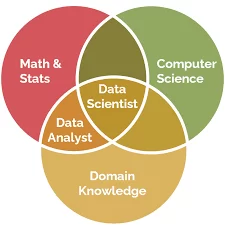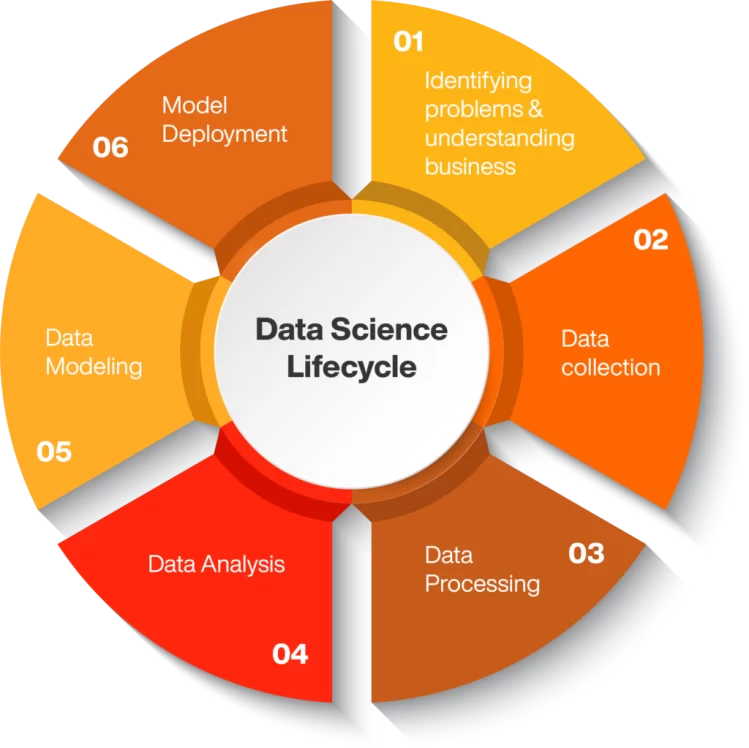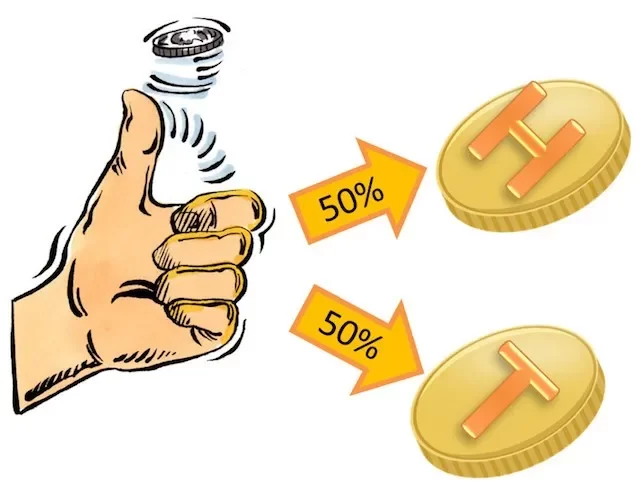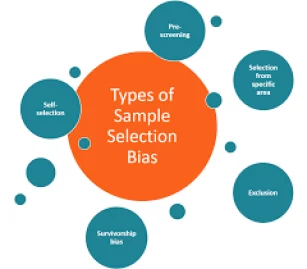
An interdisciplinary field known as data science mines and studies raw data to discover patterns that can be used to gain useful understandings.
Data science is based on statistics, computer science, machine learning, deep learning, data analysis, and data visualization, among other technologies. Due to the significance of data, data science has grown in popularity over time.

Data is regarded as the new oil of the future, and when properly studied and used, it can provide stakeholders with significant benefits. A data scientist also has the opportunity to work in a variety of fields and use cutting-edge technologies to solve real-world problems.
Fast food delivery in apps like Uber Eats, which helps the delivery person show the fastest route from the restaurant, is the most common real-time application. Item recommendation systems on e-commerce sites like Amazon, Flipkart, and others use data science to suggest products to customers based on their past searches.
Data Science is becoming increasingly popular in fraud detection applications for credit-based financial applications as well as recommendation systems.

A successful data scientist can solve problems that help drive business and strategic goals, interpret data, and bring out creativity.
As a result, it is now the highest-paying job in the 21st century.
A- It is impossible to conduct data analysis on an entire volume of data at once, particularly when dealing with larger datasets.
Obtaining data samples that are representative of the entire population and performing analysis on them becomes critical. To accurately represent the entire dataset, sample data must be carefully picked from the vast amount of data.
A- Data science is the process of transforming data through a variety of technical analysis techniques to extract useful insights that a data analyst can use in their business scenarios.
To improve and improve the efficiency of business-related decision-making, data analytics focuses on verifying existing hypotheses and information and providing answers to questions. By finding answers to questions that lead to connections and solutions to problems of the future, data science stimulates innovation.

Predictive modeling is the focus of data science, whereas data analytics focuses on extracting current meaning from historical context.
While data analytics can be thought of as a specific field dealing with specific concentrated problems using fewer tools of statistics and visualization, data science can be thought of as a broad subject that uses various mathematical and scientific tools and algorithms to solve complex problems.
A- An interdisciplinary field that comprises different logical cycles, calculations, instruments, and AI strategies attempting to assist with finding normal examples and assembling reasonable bits of knowledge from the given crude information utilizing factual and numerical investigation is called Information Science.
The data science life cycle is depicted in the figure below. The first step is to gather the necessary information and business requirements. Data cleaning, warehousing, staging, and architecture are used to keep the data up to date after it is acquired.

The process of exploring, mining, and analyzing data is done by data processing, which can then be used to produce a summary of the insights.
Depending on the requirements, the cleansed data is subjected to a variety of algorithms. For eg – predictive analysis, regression, text mining, and recognizing patterns, after the exploratory steps have been completed. The business is shown the results in a way that is appealing to the eye in the final stage. Data visualization, reporting, and various business intelligence tools are all important at this point.
A-Resampling is a method for sampling data to increase accuracy and reduce the uncertainty associated with population parameters. By training the model on various patterns from a dataset to ensure that variations are handled, it is done to ensure that the model is adequate. It is also done when models need to be validated with random subsets or when data point labels are changed during tests.
A-Information is supposed to be exceptionally imbalanced on the off chance that it is disseminated inconsistently across various classes. Model performance is erroneous and inaccurate as a result of these datasets.
A-There aren’t many differences between these two, but they’re used in different situations. In situations involving random variables, the expected value is referred to. On the other hand, the mean value typically refers to the probability distribution.

A: The logical error of focusing on things that made it through a process and ignoring things that didn’t work because they weren’t prominent is known as this bias. The wrong conclusions may be drawn as a result of this bias.
A- KPI
A key Performance Indicator, or KPI, is a metric that tracks how well a company achieves its goals.
This is a comparison of the target model’s performance to that of a random choice model. Lift indicates the model’s prediction accuracy in comparison to the absence of a model.
This tells you how well the model you’re looking at fits the data.
This shows how well the system can deal with differences and variances.
It stands for the design of experiments, which is the task design that aims to describe and explain the variation in information under hypothesized conditions that are representative of variables.
A- Confounders are another name for variables that confuse. Extraneous variables of this kind have an impact on both independent and dependent variables. It may result in spurious associations and mathematical relationships between variables that are associated but are not casually related to one another.
A- The determination predisposition happens in the situation when the scientist needs to settle on a choice on which member to study. The determination predisposition is related to those explored when the member choice isn’t irregular. The selection effect is another name for the selection bias. The method used to collect the samples results in selection bias.

The following is a breakdown of the four types of selection bias:
A biased sample is the result of a population that is not entirely random, with some members of the population having a lower chance of being included than others. This causes a purposeful blunder known as studying predisposition.
If we reach any extreme value, trials may be stopped early. However, if all variables are invariant, the variables with the highest variance have a greater chance of getting the extreme value.
It occurs when particular data are chosen erratically and the generally accepted measures are not adhered to.
Wearing down in this setting implies the deficiency of the members. It involves excluding subjects whose trials were not completed.
Data science is a very broad field that covers a wide range of topics. For eg – data mining, data analysis, data visualization, machine learning, deep learning, etc. Most significantly, it is built on mathematical ideas like linear algebra and statistical analysis.
There are a lot of needs for becoming a good professional Data Scientist. It means there are a lot of advantages if you pursue a professional data science course. These days, the most sought-after job title is Data Scientist.
We provide online certification in Data Science and AI, Digital Marketing, Data Analytics with a job guarantee program. For more information, contact us today!
Courses
1stepGrow
Terms
Anaconda | Jupyter Notebook | Git & GitHub (Version Control Systems) | Python Programming Language | R Programming Langauage | Linear Algebra & Statistics | ANOVA | Hypothesis Testing | Machine Learning | Data Cleaning | Data Wrangling | Feature Engineering | Exploratory Data Analytics (EDA) | ML Algorithms | Linear Regression | Logistic Regression | Decision Tree | Random Forest | Bagging & Boosting | PCA | SVM | Time Series Analysis | Natural Language Processing (NLP) | NLTK | Deep Learning | Neural Networks | Computer Vision | Reinforcement Learning | ANN | CNN | RNN | LSTM | Facebook Prophet | SQL | MongoDB | Advance Excel for Data Science | BI Tools | Tableau | Power BI | Big Data | Hadoop | Apache Spark | Azure Datalake | Cloud Deployment | AWS | GCP | AGILE & SCRUM | Data Science Capstone Projects | ML Capstone Projects | AI Capstone Projects | Domain Training | Business Analytics
WordPress | Elementor | On-Page SEO | Off-Page SEO | Technical SEO | Content SEO | SEM | PPC | Social Media Marketing | Email Marketing | Inbound Marketing | Web Analytics | Facebook Marketing | Mobile App Marketing | Content Marketing | YouTube Marketing | Google My Business (GMB) | CRM | Affiliate Marketing | Influencer Marketing | WordPress Website Development | AI in Digital Marketing | Portfolio Creation for Digital Marketing profile | Digital Marketing Capstone Projects
Jupyter Notebook | Git & GitHub | Python | Linear Algebra & Statistics | ANOVA | Hypothesis Testing | Machine Learning | Data Cleaning | Data Wrangling | Feature Engineering | Exploratory Data Analytics (EDA) | ML Algorithms | Linear Regression | Logistic Regression | Decision Tree | Random Forest | Bagging & Boosting | PCA | SVM | Time Series Analysis | Natural Language Processing (NLP) | NLTK | SQL | MongoDB | Advance Excel for Data Science | Alteryx | BI Tools | Tableau | Power BI | Big Data | Hadoop | Apache Spark | Azure Datalake | Cloud Deployment | AWS | GCP | AGILE & SCRUM | Data Analytics Capstone Projects
Bangalore:
Anjanapura | Arekere | Basavanagudi | Basaveshwara Nagar | Begur | Bellandur | Bommanahalli | Bommasandra | BTM Layout | CV Raman Nagar | Electronic City | Girinagar | Gottigere | Hebbal | Hoodi | HSR Layout | Hulimavu | Indira Nagar | Jalahalli | Jayanagar | J. P. Nagar | Kamakshipalya | Kalyan Nagar | Kammanahalli | Kengeri | Koramangala | Kothnur | Krishnarajapuram | Kumaraswamy Layout | Lingarajapuram | Mahadevapura | Mahalakshmi Layout | Malleshwaram | Marathahalli | Mathikere | Nagarbhavi | Nandini Layout | Nayandahalli | Padmanabhanagar | Peenya | Pete Area | Rajaji Nagar | Rajarajeshwari Nagar | Ramamurthy Nagar | R. T. Nagar | Sadashivanagar | Seshadripuram | Shivajinagar | Ulsoor | Uttarahalli | Varthur | Vasanth Nagar | Vidyaranyapura | Vijayanagar | White Field | Yelahanka | Yeshwanthpur
Other Top Cities:
Mumbai | Pune | Nagpur | Delhi | Gurugram | Chennai | Hyderabad | Coimbatore | Bhubaneswar | Kolkata | Indore | Jaipur and More